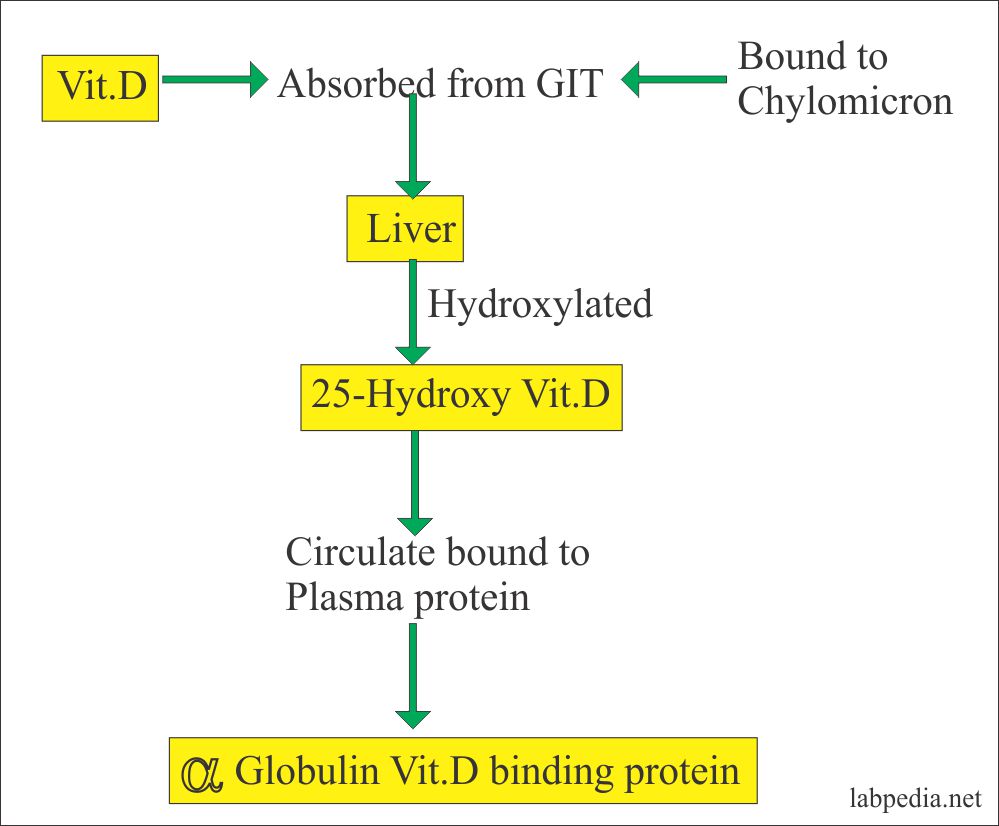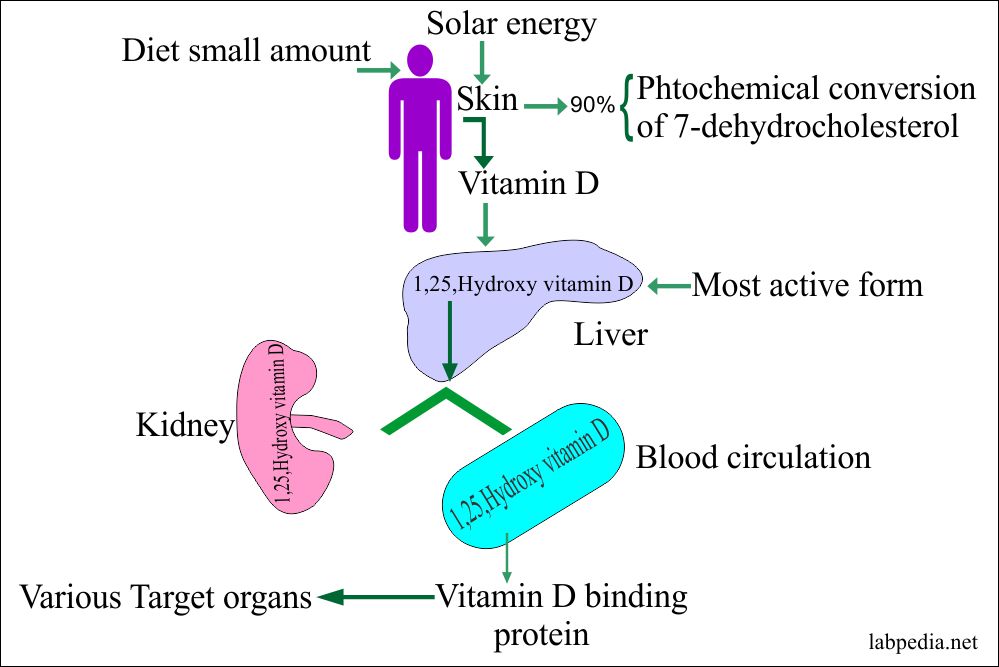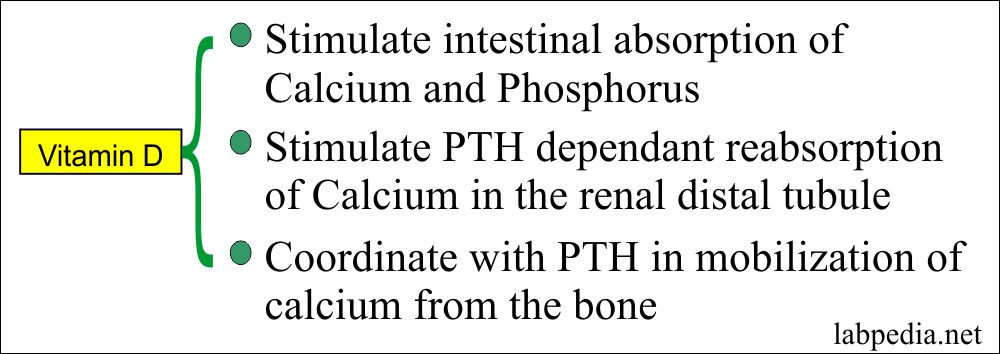Vitamin D (Vitamin D2 and D3)
Sample
- Venous blood is needed to prepare the serum.
- A random sample can be used.
- The sample is stable at room temperature for 72 hours.
- The sample is stable at 22 to 25 °C.
Purpose Of The Test (Indications)
- Indicated in the postmenopausal women to evaluate Vit.D level which is needed for the absorption of Calcium.
- To evaluate the role of Vit.D in osteoporosis.
- To find the role of Vit.D in the prevention of cancer.
Pathophysiology
- Vitamin D is a fat-soluble vitamin and it is hormone-like steroids.
- 7-hydrocholesterol in the skin by the sunlight (ultraviolet rays), converted into D2 and D3.
- Vitamin D is found in two forms:
- Vitamin D2 (Ergocalciferol).
- Vitamin D3 (Cholecalciferol).
- Vit.D3 absorption:
- In the diet vitamin D is in two forms:
- Cholecalciferol D3)
- Ergocalciferol (Vitamin D2).
- 1.25,(OH)2 D3 stimulates the intestinal absorption of Ca++ and PO//.
- For its absorption bile salts are needed.
- It is stored in the liver and excreted in the bile.
- Under the influence of the PTH, it helps for:
- Bone growth.
- Metabolism.
- Sources of VitamD2 are:
- A dietary source of fish that is rich in Vit.D.
- The artificial source is milk, breakfast cereals, and supplement.
- Vit.D3 sources are:
- Animal food.
- Fatty fish.
- Eggs.
- Liver.
- Butter.
- Vitamin D3 produced in the skin under the influence of sunlight.
- There is a special effect of ultraviolet light (ultraviolet B radiation).
- 7-dehydrocholesterol under the influence of ultraviolet-B light converted into vitamin D3.
- The wavelength of ultraviolet light is 270 to 300.
- These lights are present at the sea level and not seen in the arctic circle.
- An adequate amount of vitamin D3 forms when you are exposed to the sun for 10 to 15 minutes a week.
- Don’t use sunblock.
- Vitamin D formation depends upon the melanin contents. The people with more melanin needs more time.
- Vitamin D from the skin or from food is converted into 1,25, dihydroxy vitamin D in the liver, and kidney.
- 1,25, dihydroxy vitamin D is a hormonally active form of vitamin D and released into circulation.
- It binds to a carrier protein (vitamin-D binding protein VDBP) and goes to various target organs.
- Vitamin D receptors (VDR) are present in the nucleus.
- Binding of vitamin D3 to VDR of target cells, now VDR acts as a transcription factor.
- This will ultimately lead to the absorption of Calcium in the intestine.
- Activation of VDR in the intestine, bone, kidney, and parathyroid glands leads to the maintenance of calcium and phosphorus in the blood.
- Functions of vitamin D:
- Vit.D major role is to regulate serum calcium and phosphorus in the blood by:
- Promoting their absorption from food in the intestine.
- By promoting the reabsorption of calcium in the kidneys.
- This will prevent Rickets from growing children.
- Prevents osteomalacia in adults.
- Prevents hypocalcemic tetany.
- Vitamin D corrects and maintains the concentration of ionized calcium.
- Vit.D inhibits parathyroid hormone secretion from the parathyroid gland.
- Vit.D promotes:
- The immune system by increasing phagocytosis.
- Anti-tumor activity.
- Immunomodulatory function.
- Role in calcium absorption:
- It stimulates intestinal absorption of calcium and phosphorus.
- It stimulates the PTH dependant reabsorption of calcium in the distal renal tubule.
- It helps PTH to mobilize the calcium from the bone.
- PTH, vitamin D, and calcitonin maintain a normal amount of Ca++ in bone and plasma.
- Deficiency of vitamin D leads to:
- Rickets in the children in the growing age.
- Osteomalacia in adults.
- Prolonged deficiency causes osteopenia.
- Hypocalcemia.
- Toxicity of vitamin D:
- Overdosage of vitamin D leads to metastatic calcification of soft tissues.
- Hypervitaminosis of vitamin D (calcitriol) leads to hypercalcemia.
- Increased level of vitamin D increases intestinal absorption and excessive bone resorption.
- Increased vitamin D leads to increased calcium and suppress the PTH.
Causes Of Vit.D Deficiency Are:
- Inadequate dietary intake.
- Inadequate sunlight exposure.
- Malabsorption syndrome.
- Liver or kidneys disorders.
- Metabolic hereditary disorders.
- Vit.D deficiency leads to:
- Bone softening diseases like,
- Rickets in children.
- Osteomalacia in adults.
- Osteoporosis.
- Recent evidence is that deficiency may be associated with cancers of the colon, breast, and pancreas.
- This may be associated with an increase in blood pressure and cardiovascular disease risk.
People At Risk Of Vit.D Deficiency Are:
- Infants on breastfeeding (human milk is deficient in Vit.D).
- Occupation when people are not exposed to the sun.
- Individual too fatty with body mass index (BMI) >30 because Vit.D is trapped in fatty tissues.
- Malabsorption from GIT.
- Patient with liver or kidneys diseases.
Measurement Of Vit.D:
- Measure 25-hydroxy D2 and D3 = Total Vit D.
- Treatment is based on the total Vit.D level.
Normal Total Vit.D:
Source 1
- 16 to 65 pg/mL
- Maternal concentration is 2-fold higher.
Other sources
- Indicate vit.D deficiency = <20 ng/mL
- Insufficiency of vit.D = 20 to 30 ng/mL
- Optimal level of vit.D = >30 ng/mL
- Toxic level of vit.D = >200 ng/mL
- Recommended dose of vitamin D for adult is 5 µg/day.
Increased Level Of Vit.D:
- Excessive dietary supplement.
- William syndrome. This is a rare genetic disorder.
Decreased Level Of Vit.D:
- Rickets.
- Osteoporosis.
- Liver diseases.
- Renal diseases.
- Inadequate dietary intake.
- Inadequate exposure to sunlight.
- Acute inflammatory diseases.
- Familial hypophosphatemic rickets.













0 Comments